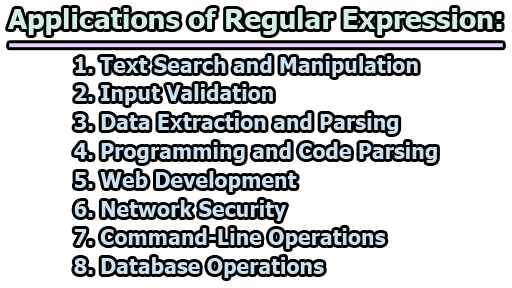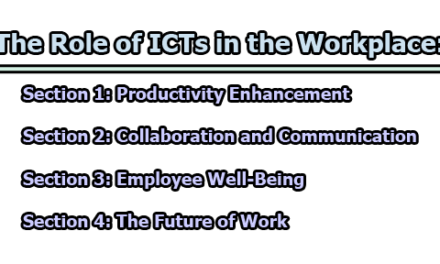A regular expression (regex or regexp) is a sequence of characters that forms a search pattern. It is a powerful tool for text processing and pattern matching. Regular expressions are used in various programming languages, text editors, and command-line utilities to search, manipulate, and validate strings of text based on a specified pattern. In this article, we are going to know about regular expression and applications of regular expression.
Definitions Regular Expression:
From a scholarly perspective, a regular expression serves as a formal language to specify patterns within strings, facilitating operations such as text search, manipulation, and validation.
Dr. Jeffrey E. F. Friedl, a renowned expert in regular expressions, provides an insightful definition in his authoritative book, “Mastering Regular Expressions.” According to Dr. Friedl, a regular expression is “a pattern that describes a set of strings” and can be viewed as a “mini-programming language” dedicated to string matching (Friedl, 2006). This definition emphasizes the fundamental concept that regular expressions are not mere static patterns but dynamic entities capable of representing sets of strings.
The syntax of regular expressions, rooted in mathematical formalism, allows for the concise representation of intricate patterns. Dr. Friedl elucidates the syntax by stating that a regular expression “may include ordinary characters, which simply match themselves, and special characters, which control the pattern-matching process” (Friedl, 2006). This delineation underscores the dual nature of regular expressions, combining simplicity with sophistication to capture the nuances of textual patterns.
From a linguistic perspective, Dr. Jan Goyvaerts, a linguist and regular expression enthusiast, provides an illuminating definition on his website, Regular-Expressions.info. He describes a regular expression as “a sequence of characters that defines a search pattern” and emphasizes its utility in “finding and replacing text” (Goyvaerts, n.d.). This perspective underscores the practical applications of regular expressions in text-related tasks, aligning with their pervasive use in programming, data analysis, and web development.
In the realm of formal language theory, the definition of regular expressions aligns with the broader classification of regular languages. Dr. Michael Sipser, a prominent computer scientist and author of “Introduction to the Theory of Computation,” places regular expressions within the context of regular languages, stating that they “describe the regular languages” and provide a concise notation for recognizing these languages (Sipser, 2012). This formal perspective anchors regular expressions in a theoretical framework, emphasizing their significance in the broader landscape of computational theory.
Applications of Regular Expression:
Here are some common applications of regular expression:
1. Text Search and Manipulation: Regular expressions are widely recognized for their prowess in text search and manipulation, offering a robust mechanism for finding and replacing specific patterns or substrings within a given text. This application is particularly valuable for tasks such as document editing, codebase maintenance, and data cleaning. In the context of text search, a regular expression allows users to define a pattern, specifying the sequence of characters they want to locate. This pattern may include literal characters, metacharacters, and quantifiers, providing a flexible and expressive syntax.
For example, a simple regular expression like `\b\d{3}\b` can be used to find three-digit numbers in a document, where `\b` denotes a word boundary, and `\d{3}` indicates exactly three digits. This enables users to identify and manipulate numerical data efficiently, whether for formatting purposes or numerical analysis.
Moreover, regular expressions excel in the manipulation of text by enabling the replacement of identified patterns with new values. This find-and-replace functionality proves immensely useful for tasks such as code refactoring, where developers can efficiently update variable names, function calls, or other code elements across multiple files simultaneously.
2. Input Validation: Regular expressions play a crucial role in input validation, ensuring that user-provided data adheres to specified formats. In web development, for instance, forms often require users to enter information in a particular structure, such as email addresses, phone numbers, or dates. Regular expressions offer a powerful means to validate and enforce these formats, preventing the submission of incorrect or potentially harmful data.
Consider a scenario where a website prompts users to enter an email address. A regular expression like `^[a-zA-Z0-9._%+-]+@[a-zA-Z0-9.-]+\.[a-zA-Z]{2,}$` can be employed to validate the input against the standard email format. This regex checks for the presence of a valid username, domain, and top-level domain, ensuring that the entered data conforms to the expected email structure.
By incorporating regular expressions into form validation processes, developers enhance the overall security and reliability of applications, mitigating the risks associated with malformed or malicious input.
3. Data Extraction and Parsing: Regular expressions play a pivotal role in data extraction and parsing, particularly in scenarios involving log analysis and the processing of structured or semi-structured data. In log files, which often contain vast amounts of information, regular expressions provide a systematic way to extract relevant details based on predefined patterns.
For instance, consider a log file containing entries with timestamps, IP addresses, and error messages. A well-crafted regular expression can be designed to capture and isolate each of these components. This facilitates the extraction of specific information, enabling analysts to identify trends, troubleshoot issues, and gain valuable insights from the log data.
In the broader context of data parsing, regular expressions are instrumental in breaking down complex data structures into manageable components. Whether dealing with CSV files, XML documents, or other formatted data, regex patterns can be tailored to extract meaningful information from the raw data, contributing to more effective data analysis and interpretation.
4. Programming and Code Parsing: Regular expressions find extensive application in the realm of programming, offering developers a powerful toolset for tasks such as code search, refactoring, and syntax highlighting in code editors. When working with large codebases, the ability to efficiently locate specific code patterns or elements is crucial for navigation, debugging, and code maintenance.
For instance, a regular expression can be employed to search for all occurrences of a particular function or variable name within a project. This enables developers to quickly assess the scope of a change, identify potential issues, and streamline the codebase.
Moreover, in code editors, regular expressions contribute to syntax highlighting by identifying and applying distinct styles to different code elements. This visual representation enhances code readability and helps developers grasp the structure of the code at a glance.
5. Web Development: Regular expressions play a pivotal role in web development, where they are employed for tasks ranging from validating user inputs to parsing and manipulating web-related data. In the context of web forms and user input, regular expressions are instrumental in enforcing data format standards. For example, when users submit URLs or dates through a form, developers can utilize regex patterns to validate and ensure the correctness of the provided data.
Consider a scenario where a web application requires users to enter a valid URL. A regular expression like `^(https?|ftp)://[^\s/$.?#].[^\s]*$` can be used to validate the format of the URL, ensuring that it starts with either “http,” “https,” or “ftp” and follows the standard structure of a web address.
Beyond input validation, regular expressions are employed in parsing HTML documents. While it’s generally advised to use dedicated HTML parsers for complex scenarios, regular expressions can be handy for simpler tasks such as extracting specific tags, attributes, or content. This versatility makes regular expressions a valuable tool in the development of web applications, contributing to both functionality and data integrity.
6. Network Security: In the realm of network security, regular expressions contribute significantly to pattern matching within network traffic logs, aiding in security analysis and the validation of IP addresses. Security professionals utilize regular expressions to identify specific patterns indicative of security threats, such as unusual network behavior or known attack signatures.
For instance, a regular expression might be crafted to detect a common type of malicious payload in network traffic. The ability to recognize and flag such patterns allows security analysts to respond promptly to potential threats, strengthening the overall cybersecurity posture.
Regular expressions also play a role in the validation of IP addresses. By defining patterns that conform to valid IP address formats, network administrators can ensure that the data being processed aligns with expected standards. This application contributes to the accuracy of security analyses and helps prevent issues arising from incorrectly formatted or manipulated IP addresses.
7. Command-Line Operations: Regular expressions streamline file operations in command-line environments, providing a powerful means to search for and manipulate files efficiently. Command-line tools often support regular expressions, allowing users to perform complex file-related tasks with concise and expressive patterns.
For example, the `grep` command, a widely used tool for searching through text, supports regular expressions to filter and extract specific lines from files. This capability is particularly useful in scenarios where users need to sift through large log files or codebases to find occurrences of particular patterns.
Regular expressions in command-line operations empower users to perform tasks such as bulk renaming of files, searching for specific content within files, and filtering files based on predefined criteria. This flexibility enhances the efficiency of file-related workflows, making regular expressions an indispensable tool for command-line enthusiasts and system administrators.
8. Database Operations: In the domain of databases, regular expressions are applied to queries for filtering and retrieving data based on specific patterns. This capability is valuable for tasks such as data cleaning, where patterns need to be identified and modified systematically.
Consider a database containing customer information, where phone numbers are stored in varying formats. A regular expression can be employed in a query to retrieve all records with phone numbers adhering to a standardized format, facilitating consistent data presentation.
Moreover, regular expressions in databases extend beyond simple pattern matching. They can be used for more complex tasks, such as identifying and extracting information from unstructured data fields. This flexibility makes regular expressions a powerful tool for data analysts and database administrators dealing with diverse datasets and data quality challenges.
In conclusion, regular expressions stand as a versatile and indispensable tool in the realm of text processing and beyond. Their ability to define and match patterns has led to widespread adoption in diverse fields, from programming to web development, data analysis, network security, and database operations. As technology continues to advance, the importance of regular expressions is likely to persist, playing a vital role in shaping the landscape of text processing and pattern matching. Understanding and harnessing the power of regular expressions empowers professionals across various domains to tackle complex tasks efficiently and effectively.
References:
- Friedl, J. E. F. (2006). Mastering Regular Expressions. O’Reilly Media.
- Goyvaerts, J. (n.d.). Regular-Expressions.info. Retrieved from https://www.regular-expressions.info/
- Sipser, M. (2012). Introduction to the Theory of Computation. Cengage Learning.

Assistant Teacher at Zinzira Pir Mohammad Pilot School and College










